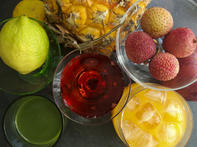As the world becomes more urban and people start to live further away from where food is produced, there is a trend towards adding value to raw agricultural products.

Juicing is a form of adding value and is an excellent way to extend the shelflife of a fruit or vegetable, adding convenience and including more nutrients and fluids to the modern-day diet.
Juicing is the process during which moisture and nutrients are extracted from plant materials such as fruit and vegetables by breaking mechanically and/or chemically the cell walls of the product.
Juicing can be a form of added value to a farmer’s product offering, but involves strict quality control measures such as proper preparation of raw materials, food safety, proper hygienic packaging and cold storage in order to produce a nutritious, tasty and safe end product.
By Marinda Louw
 Freshly-pressed juice is rich in a variety of immune-boosting agents, but processing such as chilling, blending and pasteurisation can lead ...
Freshly-pressed juice is rich in a variety of immune-boosting agents, but processing such as chilling, blending and pasteurisation can lead ... Juice processing range from simply squeezing a single fruit type at home to international companies exporting blended juices world-over. The...
Juice processing range from simply squeezing a single fruit type at home to international companies exporting blended juices world-over. The... The juicing of fruit and vegetables is older than agriculture itself. Hunter-gatherer people have collected ripened fruit in simple vessels ...
The juicing of fruit and vegetables is older than agriculture itself. Hunter-gatherer people have collected ripened fruit in simple vessels ... Processing of a fresh product to extract its juice involves more than just squeezing it into a container. The aim is also to increase shelfl...
Processing of a fresh product to extract its juice involves more than just squeezing it into a container. The aim is also to increase shelfl...